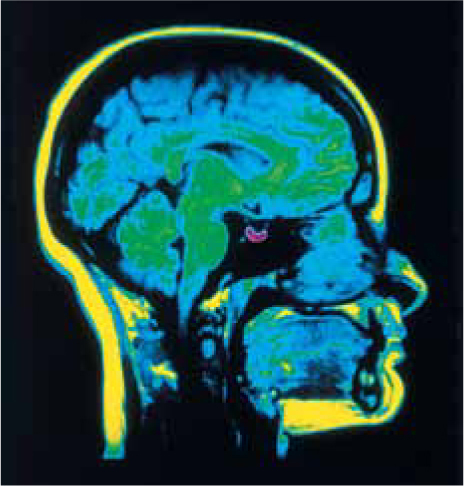ASTRONOMY DOWN TO EARTH
Spin-Flip Transitions in Medicine
Thanks to their spin, protons and electrons act like microscopic bar magnets. In a hydrogen atom, the interaction between the magnetism of the electron and that of the proton gives rise to the 21-cm radio emission. But these particles can also interact with outside magnetic fields, such as that produced by a large electromagnet. This physical principle is behind magnetic resonance imaging, an important diagnostic tool of modern medicine.
Much of the human body is made of water. Every water molecule has two hydrogen atoms, each of which has a nucleus made of a single proton. If a person’s body is placed in a strong magnetic field, the spins of the protons in the hydrogen atoms of their body can either be in the same direction as the field (“aligned”) or in the direction opposite to the field (“opposed”). The aligned orientation has lower energy, and therefore the majority of protons end up with their spins in this orientation. But if a radio wave of just the right wavelength is now sent through the person’s body, an aligned proton can absorb a radio photon and flip its spin into the higher-energy, opposed orientation. How much of the radio wave is absorbed depends on the number of protons in the body, which in turns depends on how much water (and, thus, how much water-containing tissue) is in the body.
In magnetic resonance imaging, a magnetic field is used whose strength varies from place to place. The difference in energy between the opposed and aligned orientations of a proton depends on the strength of the magnetic field, so radio waves will only be absorbed at places where this energy difference is equal to the energy of a radio photon. (This equality is called resonance, which is how magnetic resonance imaging gets its name.) By varying the magnetic field strength over the body and the wavelength of the radio waves, and by measuring how much of the radio wave is absorbed by different parts of the body, it is possible to map out the body’s tissues. The accompanying false-color image shows such a map of a patient’s head.
Unlike X-ray images, which show only the densest parts of the body, such as bones and teeth, magnetic resonance imaging can be used to view less dense (but water-containing) soft tissue. Just as the 21-cm radio emission has given astronomers a clear view of what were hidden regions of our Galaxy, magnetic resonance imaging allows modern medicine to see otherwise invisible parts of the human body.
